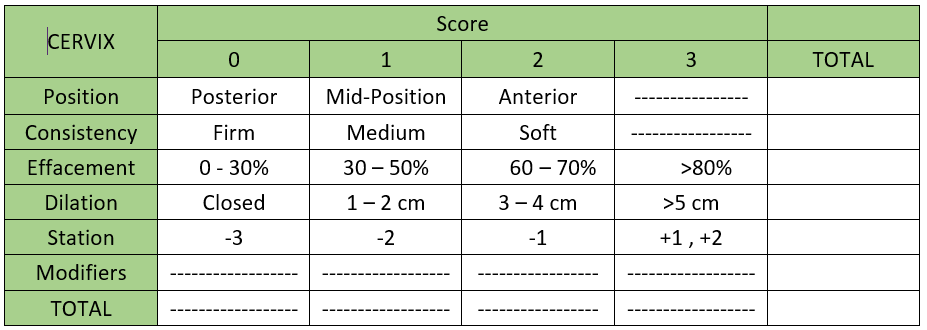What is a bishop score calculator and why is it important to know your score? Everything natural birth hopefuls need to know about a Bishop Score if a doctor recommends inducing labor.
Sadly, many doctors won’t tell you about the Bishop Score Calculator and the importance of a Bishop Score in determining the likelihood of a successful induction. So, I want this to be my contribution to your pregnancy.
As a natural birth hopeful the first time around, I was researching natural birth not because I was scared of labor, but because I was scared of needles.
No joke, I was more afraid of needles and doctors than I was of the idea of having a baby accidentally on the side of the road. Call me crazy, but I kept hoping for it because I didn’t want to end up at the hospital surrounded by white coats and hooked up to machines.
My research and subsequent natural birth preparation class solidified my fear of having unnecessary interventions in the birthing process. The more I learned, the less my desire to have a natural birth was about the needles (though they still frightened me.
Instead, I began to focus on my ability to birth my baby without fear and unnecessary drugs.

One of the main things I learned is that one intervention increases your chances for subsequent interventions. This, in turn, greatly increases your chances for your natural birth plans to end up in cesarean section.
This was the epitome of hell in my mind. So, I learned about all the ways to avoid medical interventions in my births, knowing I may not have full control, but I wasn’t going to be talked into something that wasn’t right.
If you’re hoping for a natural birth and are considering an induction, you need to know what a Bishop Score is and how to calculate it using a Bishop Score Calculator.
Everything You Need to Know about a Bishop Score Calculator
What is a Bishop Score?
A Bishop Score rates your cervix for delivery. A doctor may use a Bishop Score to determine if you need an induction or the likelihood of pre-term delivery.
As a patient, you and your doctor can use the Bishop Score to determine if induction is likely to be effective. A favorable score means induction will be less likely to end in C-section. However, a not-so-favorable score can indicate your body is not ready for labor and delivery. An induction under this circumstance can lead to more interventions and increase your likelihood of a cesarean section.
What is a Bishop Score Calculator?
In very simple terms, a Bishop score rates individual cervical factors, including:
- position
- consistency
- effacement
- dilation
The Bishop score calculator will also rate the fetal station, or where your baby’s head is.
None of the rating factors, when used alone, can determine how close you are to going into labor. Some moms have been told near their due date that they have not dilated, or dilated very little and should not expect to be in labor on their own any time soon. In some cases, those moms spontaneously went into labor within days of their due dates.
Related: Due Date Calculator
As moms, eager to meet their new babies, it’s easy for us to get wrapped up in our due dates and feel pressure to have an induction. And, it’s easy for doctors to use this information, if you’re not informed, to help you have your baby on a schedule that suits them. Or to keep you from being overdue.
This is why I believe it’s important to discuss your Bishop score and use your Bishop score calculator when having an examination!
Having the knowledge about a bishop score near the end of your pregnancy allows you to feel more in control of your birth. Knowing your Bishop score will help you determine whether or not induction is a viable option when you’re past your due date.
How To Calculate Bishop Score
While you’re having your examination at your doctor’s office, request the assessment of each of the aspects. Having your Bishop Score Calculator in hand lets your doctor know you wish to be as informed and in control as possible.
P.S. – You can receive a free printable Bishop Score Calculator when you join my email list! By signing up, you’ll receive access to the calculator and all the other free parenting resources and printables in my member-only section!
View the table above to get an idea of how to use your Bishop Score Calculator. Give points in the TOTAL column for each aspect.
Cerival Position Scoring:
Posterior = 0pts
Mid-Position = 1pt
Anterior = 2pts
Cervical Consistency Scoring:
Firm = 0pts
Medium = 1pt
Soft = 2pts
Cervical Effacement Scoring:
0 – 30% = 0pts
30 – 50% = 1pt
60 – 70% = 2 pts
>80% = 3 pts
Cervical Dilation Scoring:
Closed = 0pts
1 – 2 cm = 1 pt
3 – 4 cm = 2 pts
>5 cm = 3 pts
Fetal Station Scoring:
-3 = 0pts
-2 = 1pt
-1 = 2pts
+1, +2 = 3pts
Modifiers on the Bishop Score Calculator are something to discuss with your doctor if they are mentioned.
Interactive Bishop Score Calculator
What is a Good Bishop Score?
Firstly, when I say “good” I’m thinking in terms of a natural birth hopeful!
A Bishop score of 6 or less means an induction is not likely to be successful. Proceeding with induction in this instance is likely to cause great stress on your body and baby, which are obviously not ready for labor and could result in more medical interventions and increase the likelihood of C-section.
Moms planning to have a natural birth, even those who choose to have an induction should seek a Bishop score of 8 or higher for the best chances that labor happens on its own or that induction is successful.
Although we don’t always have control of our birthing situations, your best chance at achieving a natural birth is to educate yourself as much as possible. Stay informed about every aspect of your pregnancy and let your doctor know you wish to be involved in all decisions about your labor and delivery. This requires you to have knowledge of things that can sometimes seem trivial, like knowing your Bishop score and how to use a Bishop score calculator.
Can my Bishop Score predict labor?
Nope. Your medical provider can make educated guesses about your impending labor, but so many factors influence labor and sometimes, things go unnoticed that prevent labor (like my son getting lodged on a bone and delaying his due date by 13 days!)
Instead, a Bishop Score is used to provide more insights into how successful an induction might be. BUT this isn’t perfect – and I refer you back to the story I just mentioned about my son being late by 13 days. Our story could have resulted in a dangerous induction.
PIN ME

FAQs About Bishop Score and Bishop Score Calculators
Q: What is the Bishop score calculator?
A: The Bishop score calculator is a tool used by healthcare providers to assess the likelihood of a successful induction of labor for pregnant women.
Q: What factors does the Bishop score calculator consider?
A: The Bishop score calculator considers five factors: cervical dilation, cervical effacement, cervical consistency, cervical position, and fetal station.
Q: How is the Bishop score calculated?
A: Each factor is given a score of 0 to 3, and the scores are added together to get a total Bishop score. A higher Bishop score indicates a higher likelihood of a successful induction of labor.
Q: What is a good Bishop score for induction of labor?
A: A Bishop score of 8 or higher is considered favorable for induction of labor.
Q: How is the Bishop score used in clinical practice?
A: The Bishop score is used by healthcare providers to determine whether induction of labor is likely to be successful or not. It is also used to guide decisions about the best method for induction, such as the use of medications or mechanical devices.
Q: Are there any limitations to using the Bishop score calculator?
A: Yes, the Bishop score calculator is not perfect and cannot predict with certainty whether induction of labor will be successful or not. Other factors, such as maternal and fetal health, can also impact the necessity and/or success of induction.
Q: Can women use the Bishop score calculator at home?
A: Not really, but in using the Bishop score calculator in partnership with your medical provider’s calculations, you can ensure you’re given all the same information your provider has in order to more confidently make decisions with your provider about your treatment plan.


2 comments
worth reading article as we ar egoing to be parents soon thanks for sharing such information
Too many parameters. Quite a headache. Maybe I should take more time to refer to this issue.
Comments are closed.